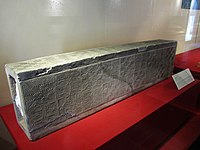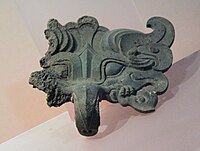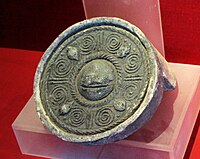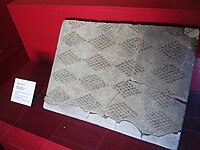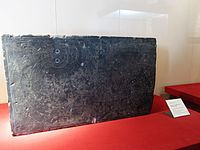
Chinese art is visual art that originated in or is practiced in China, Greater China or by Chinese artists. Art created by Chinese residing outside of China can also be considered a part of Chinese art when it is based on or draws on Chinese culture, heritage, and history. Early "Stone Age art" dates back to 10,000 BC, mostly consisting of simple pottery and sculptures. After that period, Chinese art, like Chinese history, was typically classified by the succession of ruling dynasties of Chinese emperors, most of which lasted several hundred years. The Palace Museum in Beijing and the National Palace Museum in Taipei contains extensive collections of Chinese art.

Qin Shi Huang was the founder of the Qin dynasty and the first emperor of China. Rather than maintain the title of "king" borne by the previous Shang and Zhou rulers, he assumed the invented title of "emperor", which would see continuous use by monarchs in China for the next two millennia.

The Terracotta Army is a collection of terracotta sculptures depicting the armies of Qin Shi Huang, the first emperor of China. It is a form of funerary art buried with the emperor in 210–209 BCE with the purpose of protecting him in his afterlife.
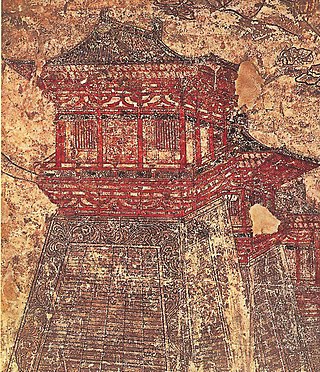
Chang'an is the traditional name of Xi'an. The site has been inhabited since Neolithic times, during which the Yangshao culture was established in Banpo, in what is now the city's suburbs. Furthermore, in the northern vicinity of modern Xi'an, Qin Shi Huang of the Qin dynasty, China's first emperor, held his imperial court and constructed his massive mausoleum guarded by the Terracotta Army.

Xianyang is a prefecture-level city in central Shaanxi province, situated on the Wei River a few kilometers upstream (west) from the provincial capital of Xi'an. Once the capital of the Qin dynasty, it is now integrated into the Xi'an metropolitan area, one of the main urban agglomerations in northwestern China, with more than 7.17 million inhabitants. Its built-up area, consisting of 2 urban districts, had 945,420 inhabitants at the 2010 census. It has a total area of 10,213 square kilometers (3,943 sq mi).

The term Chinese pyramids refers to pyramidal shaped structures in China, most of which are ancient mausoleums and burial mounds built to house the remains of several early emperors of China and their imperial relatives. About 38 of them are located around 25 kilometres (16 mi) – 35 kilometres (22 mi) north-west of Xi'an, on the Guanzhong Plains in Shaanxi Province. The most famous is the Mausoleum of the First Qin Emperor, northeast of Xi'an and 1.7 km west of where the Terracotta Army was found.
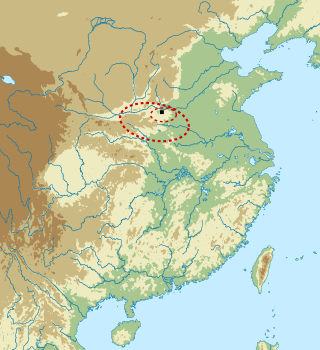
The Erlitou culture was an early Bronze Age society and archaeological culture. It existed in the Yellow River valley from approximately 1900 to 1500 BC. The culture is named after Erlitou, an archaeological site in Yanshi, Henan. It was widely spread throughout Henan and Shanxi and later appeared in Shaanxi and Hubei. Most archaeologists consider Erlitou the first state-level society in China. Chinese archaeologists generally identify the Erlitou culture as the site of the Xia dynasty, but there is no firm evidence, such as writing, to substantiate such a linkage, as the earliest evidence of Chinese writing dates to the Late Shang period.

The Feast at Swan Goose Gate, also known as the Banquet at Hongmen, Hongmen Banquet, Hongmen Feast and other similar renditions, was a historical event that took place in 206 BC at Swan Goose Gate outside Xianyang, the capital of the Qin dynasty. Its location in present-day China is roughly at Hongmenbao Village, Xinfeng Town, Lintong District, Xi'an, Shaanxi. The main parties involved in the banquet were Liu Bang and Xiang Yu, two prominent leaders of insurgent forces who rebelled against the Qin dynasty from 209 BC to 206 BC.

The burning of books and burying of scholars was the purported burning of texts in 213 BCE and live burial of 460 Confucian scholars in 212 BCE ordered by Chinese emperor Qin Shi Huang. The events were alleged to have destroyed philosophical treatises of the Hundred Schools of Thought, with the goal of strengthening the official Qin governing philosophy of Legalism.

A Chinese palace is an imperial complex where the court, civil government, royal garden and defensive fortress resided. Its structures are considerable and elaborate. The Chinese character gong represents two connected rooms (呂) under a roof (宀). Originally the character applied to any residence or mansion, but it was used in reference to solely the imperial residence since the Qin dynasty.
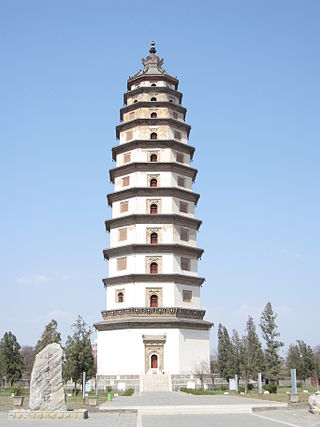
The Liaodi Pagoda of Kaiyuan Monastery, Dingzhou, Hebei Province, China is the tallest existing pre-modern Chinese pagoda and tallest brick pagoda in the world, built in the 11th century during the Song dynasty (960–1279). The pagoda stands at a height of 84 meters (276 ft), resting on a large platform with an octagonal base. Upon completion in 1055, the Liaodi Pagoda surpassed the height of China's previously tallest pagoda still standing, the central pagoda of the Three Pagodas, which stands at 69.13 m (230 ft). The tallest pagoda in pre-modern Chinese history was a 100-meter (330 ft)-tall wooden pagoda tower in Chang'an built in 611 by Emperor Yang of Sui, yet this structure no longer stands. It is considered one of the Four Treasures of Hebei.

The Twelve Metal Colossi were twelve bronze monumental statues cast after 221 BCE by the order of Qin Shi Huang, the first Emperor of China. After defeating the other six Warring States during Qin's wars of unification, Qin Shi Huang had their bronze weapons collected and melted them down to be recast as bells and statues. Particularly noteworthy among them were twelve human statues, each said to have weighed a thousand dan [about 30 tons]. The Emperor displayed them in the palace. Sima Qian considered the casting of these monumental statues as one of the great achievements of the Emperor, on a par with the "unification of the law, weights and measurements, standardization of the axle width of carriages, and standardization of the writing system". The last of the statues were destroyed in the 4th century CE. No illustrations have survived.
Ancient Chinese urban planning encompasses the diverse set of cultural beliefs, social and economic structures, and technological capacities that influenced urban design in the early period of Chinese civilization. Factors that have shaped the development of Chinese urbanism include: fengshui, and astronomy; the well-field system; the cosmological belief that Heaven is round, and the Earth is square, the concept of qi ; political power shared between a ruling house and educated advisers; the holy place bo; a three-tiered economic system under state control; early writing; and the walled capital city as a diagram of political power.

The Epang Palace was a Chinese palace complex built during the reign of Qin Shi Huang, the first emperor of China and the founder of the short-lived Qin dynasty. It is located in western Xi’an, Shaanxi Province. Archaeologists believe that only the front hall was completed before the capital was sacked in 206 BCE.

The Tomb of Khải Định, officially Ứng Mausoleum is a tomb built for Khải Định, the twelfth Emperor of the Nguyễn dynasty of Vietnam. It features a blend of Vietnamese architecture with Western styles. The tomb was completed in 1931 after 11 years of construction. It is located on Châu Chữ mountain near the former capital city of Huế. The tomb became a UNESCO World Heritage Site in 1993 as part of the Complex of Hué Monuments.

The Mausoleum of the First Qin Emperor is the mausoleum of Qin Shi Huang, the first emperor of the Qin dynasty.
Zhao Ji, personal name unknown, was the wife of King Zhuangxiang of Qin and the mother of Qin Shi Huang, the first emperor of China. Upon her marriage, she was the Lady Zhao; after the king's death, she was the Queen Dowager.

The southward expansion of the Han dynasty was a series of Chinese military campaigns and expeditions in what is now modern Southern China and Northern Vietnam. Military expansion to the south began under the previous Qin dynasty and continued during the Han era. Campaigns were dispatched to conquer the Yue tribes, leading to the annexation of Minyue by the Han in 135 BC and 111 BC, Nanyue in 111 BC, and Dian in 109 BC.
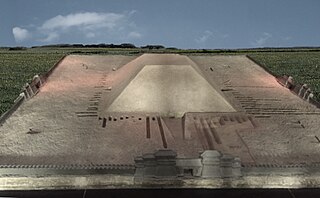
The Yangling Mausoleum of Han is the mausoleum of Emperor Jing, the sixth emperor of the Western Han dynasty and his Empress Wang. The mausoleum complex is a part of the Western Han dynasty imperial tombs located in the Weicheng district of the City of Xianyang, Shaanxi Province, on the northern bank of the Wei River and about 20 km to the north of the city center of the provincial capital of Xi'an.

The Changling or Chang Mausoleum is the mausoleum of the Han dynasty Emperor Gaozu, and for his wife Empress Lü. The Chang Mausoleum is located in the north of Sanyi Village in Yaodian Town in Weicheng District east of Xianyang in Shaanxi, China, about 20 km to the north of the provincial capital of Xi'an. Changling is one of the eleven Western Han dynasty imperial tombs located in the area around today's Xi'an.



